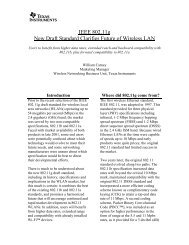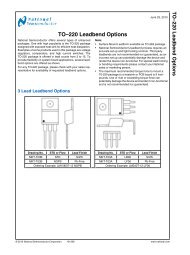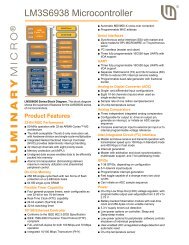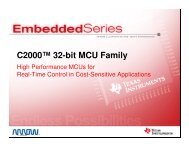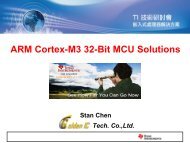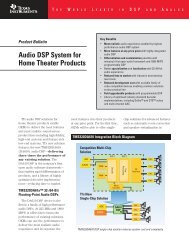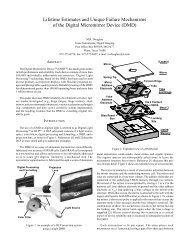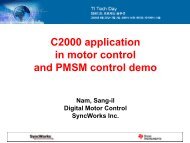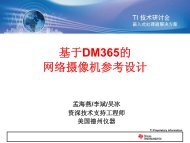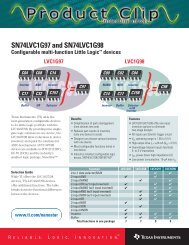DSP Implementation of an Improved DTC Technique for Induction ...
DSP Implementation of an Improved DTC Technique for Induction ...
DSP Implementation of an Improved DTC Technique for Induction ...
You also want an ePaper? Increase the reach of your titles
YUMPU automatically turns print PDFs into web optimized ePapers that Google loves.
stator d-axis flux (Wb)<br />
stator d-axis current (A)<br />
(a) Proposed Method (b) Conventional Method<br />
Figure 4 Phase Current <strong>an</strong>d d-axis Stator Flux (ωr =20 rad/s <strong>an</strong>d TL=1.2 Nm).<br />
0.5<br />
-0.5<br />
(a) Proposed Method (b) Conventional Method<br />
Figure 5 Stator Flux Trajectories <strong>of</strong> <strong>Induction</strong> Motor (ωr =20 rad/s <strong>an</strong>d TL=1.2 Nm).<br />
Experimental Results<br />
1<br />
0<br />
-1<br />
0.5<br />
0<br />
-0.5<br />
0.1 0.2 0.3<br />
time (sec.)<br />
0.4<br />
0.1 0.2 0.3<br />
time (sec.)<br />
0.4 0.5<br />
q-axis stator flux (Wb)<br />
1<br />
0<br />
-1<br />
-1 -0.5 0 0.5 1<br />
d-axis stator flux (Wb)<br />
Experimental tests were carried out on a 0.37kW squirrel-cage induction motor using a TMS320C31 floating point<br />
Digital Signal Processor (<strong>DSP</strong>) as the controller. The basic TMS320C31 <strong>DSP</strong> has been modified by the addition<br />
<strong>of</strong> 64k-words <strong>of</strong> memory, <strong>an</strong> 8-ch<strong>an</strong>nel Analogue to Digital Converter (ADC) <strong>an</strong>d 4-ch<strong>an</strong>nel Digital to Analogue<br />
Converter (DAC). The communication between the external board <strong>an</strong>d the <strong>DSP</strong> board is per<strong>for</strong>med by “built-in”<br />
control signals <strong>an</strong>d external user ports.<br />
The modified <strong>DTC</strong> method is compared with conventional <strong>DTC</strong> under the same operating conditions. The torque<br />
<strong>an</strong>d speed responses <strong>of</strong> both schemes are shown in Figure 6. It c<strong>an</strong> be observed that there is no signific<strong>an</strong>t<br />
difference between the responses under each <strong>of</strong> the schemes. Figure 8 illustrates the stator current wave<strong>for</strong>ms<br />
obtained using both the proposed <strong>DTC</strong> method <strong>an</strong>d conventional <strong>DTC</strong>. Figure 7(a) shows that the current<br />
wave<strong>for</strong>m is more sinusoidal under the proposed <strong>DTC</strong> scheme. The experimental results <strong>for</strong> stator flux locus are<br />
shown in Figure 8. It c<strong>an</strong> be seen from Figure 8(a) that the stator flux trajectory is more circular th<strong>an</strong> that under<br />
the conventional <strong>DTC</strong> scheme.<br />
1V=2.35rad/s<br />
1V=0.25Nm<br />
q-axis stator flux (Wb)<br />
4<br />
stator d-axis flux (Wb)<br />
1<br />
0.5<br />
0<br />
-0.5<br />
stator d-axis current (A)<br />
2<br />
1<br />
0<br />
-1<br />
-2<br />
0.05 0.1 0.15 0.2 0.25 0.3 0.35<br />
time (sec.)<br />
0.5<br />
0<br />
-0.5<br />
0.05 0.1 0.15 0.2 0.25 0.3 0.35<br />
time (sec.)<br />
-1<br />
-1 -0.5 0 0.5 1<br />
d-axis stator flux (Wb)<br />
1V=2.35rad/s<br />
1V=0.25Nm<br />
(a) Proposed Method (b) Conventional Method<br />
Figure 6 Torque <strong>an</strong>d Speed Responses <strong>of</strong> <strong>Induction</strong> Motor (ωref =20 rad/s <strong>an</strong>d TL=1.2 Nm).



